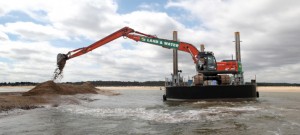There are perhaps fe

w places better equipped for studying the health of Lake Erie than Gibraltar Island.
The 6.5-acre island is home to the Ohio State University Stone Laboratory where summer classes and a guest lecture series are underway.
Ohio EPA director Craig Butler — who was appointed to the position in January by Gov. John Kasich — kicked off the series Thursday to primarily discuss two main themes: lake dredging, and phosphorus farm runoff.
Dredging in the Western Basin remains a critical topic of discussion for Butler's department, he said, since the area is one of the shallowest and most heavily dredged areas in the Great Lakes.
"What we do with that dredge material is a huge challenge," Butler said.
Butler and the EPA have condemned the cheap method of open lake dumping. He discussed healthier alternatives and uses for the sediments.
Some potential uses for it include:
-Mine reclamation projects
-Beach nourishment
-Topsoil enrichment
-Ohio Department of Transportation bridge abutment projects
-Landfill cover
-Brownfield redevelopment
The topic has been widely discussed locally. In December, U.S. Rep Marcy Kaptur (D) signed a letter from Great Lakes lawmakers asking a conference committee writing the Water Resources Reform and Development Act to include a provision giving direction to the U.S. Army Corps of Engineers.
"They spend the least amount of money in our part of the country," Kaptur said at the time.
Butler also said the Army Corps manages projects at the lowest cost possible.
It is quite possible, then, the Army Corps will turn a deaf ear to one of Butler's proposals that would cost about 25 percent more than traditional dredging methods.
"When you dredge material, there is a lot of water," Butler said. "Rather than mixing (material) with water, (you) dry it out within a year for beneficial use."
It would be a compromise, he said.
"To me, that's not a bad tradeoff, to be able to harvest that material seven to eight years sooner," he said of the sediment during this method that separates it from water.
Perhaps the only more frequently talked about subject involving Lake Erie is that of phosphorus runoff from farm fields, which Butler briefly touched on Thursday.
He said there is still a long way to go, though farmers and legislators alike are making strides.
Farmers currently receive tax breaks for using field tiles.
Senate Bill 150 was recently passed, marking a significant achievement, he said.
"It's the first time in history farmers are required to do soil testing," Butler said.
The health of the lake is important for several reasons, one simply being money.
Lake Erie and its tourist activities provide $784 million in annual state and local taxes, according to Butler. It also spurs $11.5 billion in expenditures for travel and tourism, he said.
A student asked Butler about the economic benefits of agriculture
"Agriculture is the No. 1 industry in every category," Butler said.
But that does not mean farmers can't compromise and work towards less harmful methods.

